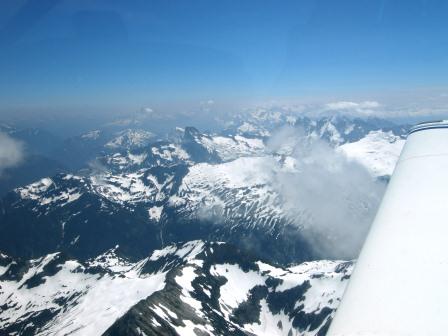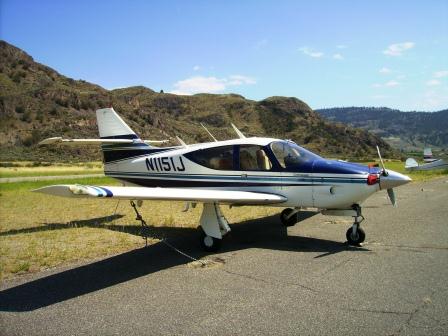Flying the Edge of America
Bellingham and the Cascade Mountains, Washington
When Julia and David left Victoria the weather was absolutely
clear; except for a little low lying mist. It shrouded the many
small islands dotting the waters between the USA and Canada. On
landing back in the USA, at Bellingham International Airport,
they were checked in by US customs. The check-in was a painless
experience. David had worried a lot about leaving and returning
to the United States in Matilda (their trusty aircraft). But the
customs agents, both in Canada and the United States, were
friendly and professional to them. Each agent was amazed as
Julia and David explained their flight around America to them.
The customs officer at Bellingham assured Julia that he felt
comfortable their airplane would make the trip all the way
around America, after Julia had voiced her concerns to him to
the contrary. He was more worried whether their pocketbook would
make it.

David was thankful the weather was clear as what lay before them was the
awesome and mighty Cascade Mountain range. From the very earliest stages of
planning the trip this flight filled David with the most trepidation. The
highest volcanic peak, Mount Rainier at 14,411 feet, is much higher than
Matilda can fly even if she is completely empty. They had tested Matilda up
to 11,500 feet, so the plan had them flying no higher than this. Their route
through the Cascades wiggled around the taller peaks following the lowest
possible terrain. Matilda needs lots of time to climb up to 11,500 feet, so
David factored this into the route. But they had the best possible weather,
clear blue skies, and mild winds. David thought their luck with the clear
weather was amazing given how awful it had been since leaving Oakland. He
hoped their luck would hold out. Julia made sure she took her medication
before this flight.

Wind can be a major problem while flying over and through high mountains.
The jagged peaks and long high ridges create rotating air masses when fast
moving winds blow over them. Airplanes caught in these rotors (as the winds
are known) can gain and lose thousands of feet in minutes. The airplane can
be sucked downward without enough engine power to resist the pull. Think of
a feather blowing in the wind, how it jumps up and down and seems to be at
the mercy of air currents. The size of Matilda was like a feather compared
to the massive Cascade Mountains.
At first the flight was smooth and uneventful. Once at 11,500 feet David
configured for cruise and took in the stupendous views of the snowcapped
peaks that surrounded us. The uninhabited forests were amazing and at times
were only 1,000 feet below them. If the engine had stopped while flying over
the Cascade Mountains there would be no place to land, and they would be in
wilderness a very long way away from any help; if they had been alive. These
were the sobering thoughts going through David's mind and they caused him to
scan constantly for a likely landing site. But his search was futile, as
there was no place to land out there.

Then David noticed that Matilda was flying with her nose pointing
downward. At first he was not sure what this was as they were maintaining
altitude and not descending. He rechecked the instruments and everything
seemed in order, except the speed over the ground was higher than expected.
He realized that they were caught in a rotating air mass coming off one of
the many ridgelines below. The autopilot, being very dogmatic, was doing the
only thing it could do to keep Matilda at the programmed altitude; it
pointed her nose towards the ground. It did this so some of her power could
be used to fight against the forceful upwardly moving air mass. It took only
a minute for David to remember that rotating air masses have two sides; one
moving upwards and the other moving downwards. They were currently caught in
the upward moving side so he expected to encounter the downward side soon,
and they did.
With the air mass now moving down the autopilot pointed Matilda's nose up to
try and resist the overwhelming downward force. Previously, while the air
was moving up, Matilda could resist without too much trouble. But she simply
did not have enough power, in the thin air at 11,500 feet, to oppose the
downward flowing air combined with gravity. Their speed over the ground
reduced as Matilda was now using engine power to slow their descent. This
meant the autopilot immediately overcompensated, raising Matilda's nose too
high. David had to disengage it and hand-fly her to keep them safe.
Julia was not sure how she made it over the Cascades. Probably valium was
the answer. Thank you to her doctor at Kaiser Oakland for writing the
prescription that got her through the ordeal. Mount Rainier is not only the
biggest mountain in the Cascades; it is an active volcano too. They did not
stop to visit Mount Rainier National Park, but looking at the amazing snow
covered crags of the Cascades from the airplane made them feel confident
enough to recommend it as a destination.
Continue the adventure, in my next excerpt from Flying the Edge of
America.